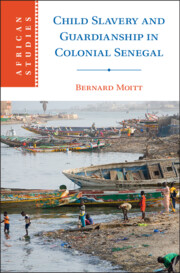Book contents
- Child Slavery and Guardianship in Colonial Senegal
- African Studies Series
- Child Slavery and Guardianship in Colonial Senegal
- Copyright page
- Dedication
- Contents
- Map of Senegal
- Figures
- Tables
- Preface
- Acknowledgments
- Introduction
- 1 Urban Senegal in the Second Half of the Nineteenth Century
- 2 The Evolution of Tutelle
- 3 Adoption of Minors and State Control of Tutelle
- 4 Legislating Guardianship, 1848–1900
- 5 Juvenile Labor, 1849–1905
- 6 The Crisis of 1903 and 1904
- 7 Minors in Institutions
- 8 Marriage, Life, Death, and Abuse
- Conclusion
- Bibliography
- Index
- African Studies Series
1 - Urban Senegal in the Second Half of the Nineteenth Century
Published online by Cambridge University Press: 19 October 2023
- Child Slavery and Guardianship in Colonial Senegal
- African Studies Series
- Child Slavery and Guardianship in Colonial Senegal
- Copyright page
- Dedication
- Contents
- Map of Senegal
- Figures
- Tables
- Preface
- Acknowledgments
- Introduction
- 1 Urban Senegal in the Second Half of the Nineteenth Century
- 2 The Evolution of Tutelle
- 3 Adoption of Minors and State Control of Tutelle
- 4 Legislating Guardianship, 1848–1900
- 5 Juvenile Labor, 1849–1905
- 6 The Crisis of 1903 and 1904
- 7 Minors in Institutions
- 8 Marriage, Life, Death, and Abuse
- Conclusion
- Bibliography
- Index
- African Studies Series
Summary
Chapter 1 offers a brief historical overview of nineteenth-century urban Senegal, with a focus on Saint-Louis. It begins with the never-ending territorial rivalry between the Portuguese, English, French, and Dutch, which ended with French dominance in the eighteenth century. It discusses the ethno-cultural groups who lived in and contributed to the economic life of the region. These were the originaires or first inhabitants of Saint-Louis, European merchants, traders, administrators, civil servants, and the métis – the product of mariage à la mode du pays (marriage according to the custom of the country) between European men and African women, whose female offspring became known as signares. The French referred to these groups collectively as habitants. Of the habitants, the signares played a significant role in the economic development of the region, and feature prominently in the chapter. They engaged in trade, including the slave trade, which, in addition to inheritances, enabled them to acquire substantial holdings in real estate, river boats, and slaves, among them children, who remained in their households as wards after the abolition of slavery. The chapter ends with the harmonious coexistence of the habitants who practiced Islam and Christianity and the Catholic religious orders that served the community.
- Type
- Chapter
- Information
- Child Slavery and Guardianship in Colonial Senegal , pp. 24 - 40Publisher: Cambridge University PressPrint publication year: 2023

